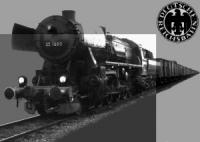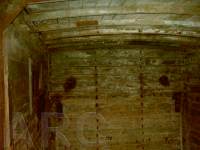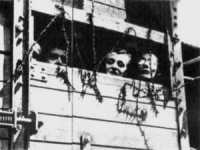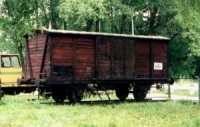The German Railways (
Deutsche Reichsbahn Gesellschaft) played an essential role in the extermination of
the European Jewry. Wherever German troops occupied a country, railway lines and a working railway infrastructure
were utilized. Many railway employees and workers of the occupied countries remained in their jobs and
worked for the Germans.
In the
Generalgouvernement, the former Polish Railways (PKP), was taken over by
Gedob
(
Generaldirektion der Ostbahnen/ General Management of the Eastern Railways) managed by Germans.
Gedob's
main headquarters was in
Krakow, but had branches in major cities such as
Warsaw, and
Lublin.
 |
| Deportation Train |
 |
| German War Locomotive |
Extermination camps were established at railway lines, as the victims were transported by
trains to the camps. The German
Reichsbahn managed its affairs virtually independently.
The SS therefore, had to pay them for transport charges. The fare in
1942 amounted
to 0.04
Reichsmark (
RM) for 1 adult per kilometre. Children paid half, and those younger
than four years were transported free of charge.
After 1939 the deportations of German Jews to the East started. The
Reichsbahn created a special group
fare, which amounted to half price, if at least 400 persons were transported with one train. No matter why the
persons were in the trains; the
Reichsbahn did not care. In order to save money, the SS tried to arrange
death trains to carry as many deportees as possible. Therefore usually 1,000-2,000 victims were thus
crowded together in cattle wagons. In
1942, trains with up to 60 wagons were
the norm, each transporting around
5,000 victims to the extermination camps. The SS forced the Jewish communities to pay the fare; one way tickets
naturally...
From 1939 to 1945 a continuous stream of trains passed each other: slow trains,
freight trains, trains for the
front and death trains - the latter integrated into the normal railway traffic. Thousands of citizens, and troops,
saw the long freight trains waiting at the stations, thirsty faces of the deportees looking out of the small
air-holes barricaded with barbed wire.
 |
| Cattle Car |
 |
| On Transport |
The level of overcrowding within the
wagons depended on the departure station. Jews from Western Europe were
sometimes transported in passenger trains which also had some freight wagons towards the rear for transporting the
luggage. Jews from the East were allowed to take only a suitcase with them. They were usually transported in
closed cattle wagons; at the start of the deportations around 50 persons in one wagon, later around 100, sometimes
even more.
The doors were locked during the transportation. Deportees received no food or water, many died on their way to
the camps. Guards, who would shoot at any Jew trying to escape, accompanied each train. Some deportees realized
their destination and tried to escape, however only a few Jews managed to free themselves from almost certain death.
The trains were very long and heavy. The running speed, therefore, was slow and other trains had priority. In
addition detours would slow down the trains which needed around 50 hours or more to complete the journey from
Germany to eastern Poland. During the hot summer months specially, death was a constant companion.
 From 1942 until late 1944
From 1942 until late 1944 mainly Jews and Romanies were brought by train to the
death camps in Poland. The
Gedob
ultimately also transported the loot, taken from the victims, back to Germany. Even
the hair, cut from the gassed women, was sent to Germany in bales,
where it was processed into insulating material and stockings for submarine personnel.
The extermination of the European Jews could not been carried out without the
cooperation and support
by all levels of the German railway personnel.
The photo was taken near
Malkinia station in
July 2002. It shows an old cattle wagon from the
1940's.
The monument is installed in memory of the deportation transports to
Treblinka,
which passed the town of
Malkinia.
Adapted from: Hilberg, Raul.
Sonderzüge nach Auschwitz.
Frankfurt/M., Berlin: Ullstein Verlag, 1987.
 |
 |
| Gedob Seal |
Former Gedob HQ
Building 2002 |
© ARC 2004












 From 1942 until late 1944 mainly Jews and Romanies were brought by train to the
death camps in Poland. The Gedob
ultimately also transported the loot, taken from the victims, back to Germany. Even
the hair, cut from the gassed women, was sent to Germany in bales,
where it was processed into insulating material and stockings for submarine personnel.
From 1942 until late 1944 mainly Jews and Romanies were brought by train to the
death camps in Poland. The Gedob
ultimately also transported the loot, taken from the victims, back to Germany. Even
the hair, cut from the gassed women, was sent to Germany in bales,
where it was processed into insulating material and stockings for submarine personnel.

